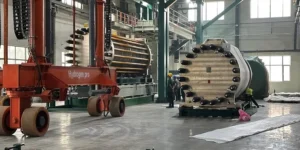Ford Shifts Focus From EVs To Hybrids – Hydrogen Fuel News

Ford’s EV Strategy Shift
Ford is reassessing its electrification strategy due to slower-than-anticipated EV adoption. CEO Jim Farley recently discussed plans to reevaluate in-house battery production and vertical integration. The company’s EV business has faced significant financial challenges, with the Model e segment incurring:
- $4.7 billion in losses last year
- An additional $1.57 billion in the first two quarters of 2023
In response, Ford is shifting focus towards hybrids while continuing production of existing EV models like the Mustang Mach-E and F-150 Lightning. The introduction of new large-scale EV projects is being postponed, including the planned three-row all-electric SUV.
The company is prioritizing financial health by delaying high-cost projects such as the T3 electric truck, now scheduled for 2027. Ford’s strategy now emphasizes:
- Cost reduction
- Adjustments to battery sourcing
- Balancing innovation with financial viability
- A more gradual transition to full electrification
Commercial and government customers remain important, with plans for a new all-electric commercial van by 2026.

Advantages of Hybrid Vehicles
Hybrid vehicles offer several advantages over full electric vehicles in the current market:
- More cost-effective due to smaller batteries
- Reduced initial costs and ongoing maintenance expenses
- Lighter weight and lower environmental impact due to smaller battery
- Effectively address range anxiety
The dual propulsion system allows drivers to switch to gasoline when electric range is exhausted, making hybrids suitable for long trips or areas with limited charging infrastructure.
Environmentally, hybrids provide a significant reduction in CO2 emissions compared to traditional gasoline vehicles. According to the U.S. Department of Energy1:
“Hybrids emit around 6,258 lbs of CO2 annually, compared to 11,435 lbs for gasoline vehicles.”
This reduction highlights hybrids’ role in bridging the gap to full electrification without requiring immediate, large-scale changes to consumer behavior or infrastructure.
Hybrid vehicles also perform well in terms of life cycle emissions, with their lower battery capacity reducing the carbon footprint associated with battery production and disposal. They offer flexibility to consumers, allowing them to experience electric driving without abandoning the reliability of gasoline engines.
The market dynamics support the attractiveness of hybrid vehicles, with other automakers like General Motors and Honda also reassessing their EV strategies to include or prioritize hybrid and plug-in hybrid models. This approach provides a more gradual transition to full electrification, allowing manufacturers time to:
- Develop cost-effective batteries
- Expand charging infrastructure
- Refine EV technology
Ford’s Revised Product Roadmap
Ford’s revised product roadmap reflects a strategic shift towards hybrid technologies. Key changes include:
| Action | Timeline |
|---|---|
| Cancellation of three-row all-electric SUV | Immediate |
| Delay of T3 electric truck | Second half of 2027 |
| Introduction of new hybrid models | Ongoing |
| Launch of medium-sized pickup on new EV platform | By 2027 |
| Production of all-new electric commercial van | Starting 2026 |
These adjustments aim to align with consumer preferences and market realities while maintaining profitability. Ford’s CFO, John Lawler, has emphasized the need for each vehicle to turn a profit quickly, reflecting a focus on financial discipline.
How Do Hydrogen Cars Fit in to the Clean Vehicle Transition
One of the primary challenges facing hydrogen vehicles is consumer range anxiety—a concern not unfamiliar to the electric vehicle (EV) market. Additionally, the infrastructure necessary for widespread hydrogen refueling, such as hydrogen stations, remains limited, further hindering adoption.
However, advancements like Honda’s innovative CR-V plug-in hydrogen car could potentially shift consumer perceptions. This vehicle combines the quick refueling benefits of hydrogen with the efficiency of hybrid technology, offering a compelling alternative for those hesitant about the current EV options. By addressing range concerns and offering faster refueling, hydrogen cars might begin to appeal more to everyday drivers.
The trajectory of hydrogen cars mirrors that of electric vehicles, which initially experienced a surge in interest from early adopters but have since faced a plateau in sales, although on a much smaller scale. This stagnation has prompted car manufacturers to pivot towards hybrids, which blend the benefits of electric and traditional combustion technologies. Hybrids are seen as a middle ground that can address consumer hesitancies while still offering environmental benefits.
In summary, Hybrids act as a vital bridge to a greener vehicle market, distinguishing themselves as a special category in the clean vehicle transition. Meanwhile, battery-powered cars have already carved out a significant role by offering zero-emission driving, yet they face challenges such as limited range and long charging times that need to be addressed to expand their appeal. The future of hydrogen cars, with their promise of quick refueling and long-range capabilities, depends heavily on technological advancements, cost reductions, and, most importantly, the development of robust infrastructure. Together, these vehicles represent a multifaceted approach to reducing carbon emissions and achieving sustainable transportation.
- U.S. Department of Energy. Emissions from Hybrid and Plug-In Electric Vehicles. Alternative Fuels Data Center.





